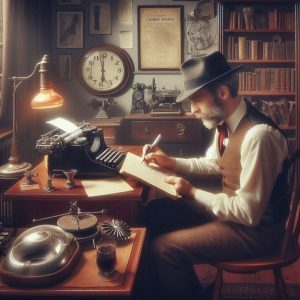
(Previous)…..(Content)…..(Next)
The first real steps of the genre
The Last War and “Science Fiction”
(Romanian)

This “episode” will be dedicated to the analysis of some “counterweight” novels to the “Fantasy” world (presented in the previous episode) through what would be the growing development of the representation of the “Science Fiction” genre.
The 1930s and 1940s represent a period in which writers emerged who would define the future of SF, appearing as a kind of “first representation” via “pulp magazines” (in the previous episode I described some elements of this “representation”).
These are the years of a time in which, from an “academic” point of view, the name “Golden Years of Pulp” appears (1930-1940), years in which the activity of magazines such as Astounding Science Fiction, SF began to be seen as more than entertainment literature, facilitating the transformations that would take place towards the clear, undeniable emergence of “Science Fiction”, without mentioning the “transformation” in what was called the “Era of Digest Magazines” (the 1950s), when SF magazines began to adopt a more compact format, and SF became more serious and literary (e.g.: The Magazine of Fantasy & Science Fiction).
But, on the other hand, during this period we are discussing here the work of some authors who were “paving” their way towards “Science Fiction”, such as:
- Isaac Asimov (Foundation, Robot Series).
- Robert A. Heinlein (Starship Troopers, Stranger in a Strange Land).
- Arthur C. Clarke (Childhood’s End, The Sentinel).
- Ray Bradbury (Fahrenheit 451, The Martian Chronicles).
which we will detail in future episodes…
But now, without further ado, let’s start with the great classics of “Science Fiction”!
Și, primul romanele „clasice” ale acelor vremuri ar fi The Mule by Isaac Asimov (1945), o povestire scurtă care a fost ulterior extinsă într-un roman și care reprezintă un punct culminant în seria Fundației (o lectură obligatorie pentru fani, care vor descoperi noi fațete ale acestui univers complex), care introduce un nou element perturbator în galaxia deja complexă creată de Asimov (alimentând o poveste plină de intrigi și suspans, care te va ține cu sufletul la gură).
And, the first of the “classic” novels of those times would be The Mule by Isaac Asimov (1945), a short story that was later expanded into a novel and which represents a culmination in the Foundation series (a must-read for fans, who will discover new facets of this complex universe), which introduces a new disruptive element into the already complex galaxy created by Asimov (fueling a story full of intrigue and suspense, which will keep you on your toes).
The Mule is a psycho-historical mutant with unlimited powers, an unpredictable force that can manipulate people’s minds on a large scale, thus undermining the Predictions of Hari Seldon (the founder of psychohistory, who predicted the fall of the Galactic Empire but could not anticipate the emergence of the Mule), creating a new dynamic in the story, the novel exploring the tension between psychohistory, a science that can predict the future, and the uncontrolled power of the human psyche, which threatens to destroy the Galactic Empire (the remaining forces of the Empire must find a way to defeat the Mule and save the galaxy).
Slan, written by A.E. Van Vogt (1940), is a kind of exploration of mutation and prejudice, being a masterpiece of science fiction that explores deep themes about evolution, prejudice, and the nature of humanity, having a significant impact on the genre, continuing to be considered essential reading.
The novel addresses the theme of mutation as a superpower, where the Slans are a race of mutants with superior mental abilities, capable of telepathy, telekinesis, and other extraordinary powers (a theme of mutation and accelerated evolution that has been explored in many subsequent works of science fiction).
The background of the narrative is constituted by prejudice and discrimination, with the Slans being persecuted and discriminated against by the society in which they live, which creates a parallel with the social problems of the time, such as racism and xenophobia, thus fueling the theme of the struggle for survival where the protagonist, Jimmy Cross, a Slan, must fight to accept his identity and survive in a hostile world.
Thus, we will go through a captivating story (a thrilling adventure), full of action, intrigue, and complex characters, constituting a reflection of fictional but also real society.

Vogt relapses through The Weapon Makers, by A.E. van Vogt (1943), a novel (considered one of the most important novels of the genre, influencing generations of writers) of the struggle for survival in a hostile universe, which explores themes such as war, power, and technological evolution in a vast and complex universe.
The novel introduces the concept of “Mechanoids”, highly intelligent mechanical creatures that have evolved into a superior race and that threaten the existence of humanity, forced to unite to face this external threat, and the protagonist finds himself at the center of this struggle, the narrative is full of action, intrigue, and complex characters.
The novel addresses themes such as totalitarianism, imperialism, and the struggle for power, in a science fiction context, with technology playing a central role in the story, and human inventions being used for both defense and offense.
And through the novel The World of Null-A by A. E. van Vogt (1945), an “essential” work of science fiction (considered one of the most important novels of the genre, influencing generations of writers), which explores complex themes such as the nature of reality, the power of the mind and the evolution of humanity in a distant future, in a futuristic society, complex and full of political intrigue, which will make you think outside the box and explore the limits of human knowledge, on an intellectual journey through a fascinating and disturbing future.
The novel introduces the concept of non-Aristotelian logic (a logical system that allows the manipulation of reality), suggesting that reality can be perceived and interpreted in infinite ways, with the protagonist, Gilbert Gosseyn, possessing extraordinary mental abilities that allow him to manipulate the reality around him, exploring the depths of the human psyche, revealing the potential and dangers of the mind, in a world that struggles for control over technology and society.
Gray Lensman by E.E. “Doc” Smith (1940) is another cornerstone of the space opera genre, a continuation of the series begun with “Galactic Patrol” (1938), which expands the vast and complex universe created by Smith, introducing us to new worlds and civilizations.
Thus, we follow the evolution of Kimball Kinnison, who becomes a Lensman (a special order of guardians of the galaxy, endowed with extraordinary mental powers) with increasingly greater powers and greater responsibilities, participating in the fight for the galaxy, the conflict between good and evil intensifying (via an evil force that threatens the entire galaxy), and the Lensmen face new threats to the galaxy.
The novel presents futuristic technologies and fascinating scientific concepts, such as interstellar travel, energy weapons, and instant communications, “supporting” an epic adventure through a captivating narrative, full of action, intrigue, and charismatic characters.
Second Stage Lensmen (or “Lensmen of Second Stage” in some translations), by E. E. “Doc” Smith (1941 – 1942) is a direct sequel to the novel “Galactic Patrol” and represents the second volume of the “Lensmen” series, a series that had a significant impact on the science fiction genre, setting the standards for space opera.
So, it is an epic continuation of a space saga, which continues to develop a vast and complex universe, full of action, intrigue and charismatic characters, introducing new alien races, technologies and threats, continuing to follow the evolution of Kimball Kinnison, who becomes an increasingly powerful and experienced Lensman.
The conflict between good and evil intensifies, and the Lensmen face new enemies and increasingly complex challenges, the novel addressing themes such as the nature of power, responsibility, and the destiny of humanity, through an optimistic vision of the future of humanity, in which humans have conquered space and created a society based on order and justice.

Another outstanding “Science Fiction” of the period is “Shadow Over Mars” (The Nemesis from Terra), by Leigh Brackett (1944) (considered one of the most important female science fiction writers), an epic Martian adventure, it is a science fiction classic, which transports us to the Red Planet in an action-packed and intriguing adventure, full of action and charismatic characters.
Unlike many other works that present Mars as a desert planet, Brackett offers us a picture of a planet populated by different alien races with history and their own cultures and conflicts, interacting with a complex and ambitious protagonist (Rick Urquhart, an adventurer who arrives on Mars and becomes involved in a political conflict), who becomes involved in a struggle for power on Mars (in opposition to a terrestrial company that exploits Mars’ resources and opposes Martian independence), the novel exploring political and social themes, such as imperialism, rebellion, and the power struggle.
As a “miscellaneous fact”, the influence of Burroughs, especially the “John Carter of Mars” series, in creating a Mars full of adventure and mystery is evident.
Kallocain written by Karin Boye (1940) is a dystopian novel, which presents us with a dark, deeply disturbing vision of totalitarianism (written during a period marked by the rise of Nazism and Communism, this work explores the extreme consequences of social control and psychological manipulation).
Published several years before novels such as “1984” and “Brave New World“, “Kallocain” anticipates many of the themes that would become central to dystopian literature, being described as “A dystopia before dystopias”.
The novel presents a drug (a truth drug), Kallocain, that forces anyone who consumes it, to tell the truth, a concept that creates dramatic tension and questions the very notion of truth in a totalitarian regime (the World State) that seeks to eliminate any form of independent thought.
The protagonist, Leo Kall, is a complex scientist who struggles with his own conscience and societal pressure, the novel explores themes such as loyalty, betrayal, guilt, and resistance, constituting itself a strong warning against any form of totalitarianism, underlining the dangers of psychological manipulation and social control.
Another similar “manifestation” would be the novel Earth’s Last Citadel, written by C.L. Moore and Henry Kuttner (1943), which takes us to a distant future, to a devastated and desolate Earth (post-apocalyptic, dystopian), where only a few human enclaves survive (Carcasilla being the last citadel of humanity), the novel (a survival story) combining elements of science fiction, fantasy and horror, creating a unique and captivating atmosphere.
Unlike many science fiction works of the time, which focused on space exploration and the distant future, “Earth’s Last Citadel” presents us with a devastated Earth, after a global catastrophe destroyed civilization, on this desolate Earth, evolution takes an unexpected turn, and mutant and dangerous creatures take control, and the survivors are “forced” to learn to collaborate to survive.
In utopian “opposition,” we have the novel Beyond This Horizon, written by Anson MacDonald (Robert A. Heinlein) (1942), an emblematic work of science fiction that transports us to a utopian future, where science and technology have solved many of humanity’s problems, through access to advanced technologies.
Heinlein presents us with a society in which people live in harmony with nature and technology is used to improve the quality of life, with the novel exploring the theme of space colonization and contact with other extraterrestrial civilizations.
Additionally, it examines the concept of social engineering, exploring the possibilities of creating a perfect society through science but, unlike many dystopian works of the era, it offers us an optimistic vision of the future of humanity.
Another “classic”, “forgotten” utopia would be Islandia, by Austin Tappan Wright (1942), a fascinating work that transports us to an idealized world, isolated from the rest of the world (an isolated island, with an ancient and wise civilization), captivating the reader with its vision of a perfect society and with the detailed descriptions of a unique culture, immersed in an adventure story, following the travels and experiences of the protagonist (John Lang, an American who discovers Islandia and is fascinated by this society).
Wright constructs an ideal society, Iceland, with its own laws, customs, and values, describing in detail the daily life of Icelanders, from their politics and economy to art and literature, contrasting Iceland with the modern world, offering a subtle critique of the values and institutions of Western society.
Das Glasperlenspiel [The Glass Bead Game], by Hermann Hesse (1943) is an intellectual, complex, and profound utopia that explores themes such as knowledge, art, spirituality, and the nature of human society, the author introduces us to an ideal world, Castalia (a utopian society, isolated from the outside world), where knowledge and art are the highest values.
In this society, a complex intellectual game, The Crystal Glass Game, becomes how all fields of knowledge are integrated, the novel being, in fact, a subtle critique of modern society, with its technological excesses and its materialism.
The protagonist, Joseph Knecht (a talented young man who becomes the Game Master), faces an existential crisis, questioning the meaning of life and knowledge, as a metaphor for the search for absolute knowledge (the novel is full of symbolism).

Another utopia, this time “Christian”, is represented by the novel Perelandra, by C.S. Lewis (1943), a Garden of Eden (an Edenic Venus) in space, the second novel in C.S. Lewis’s Space Trilogy and represents a fascinating exploration of Christian themes and allegory (Christian, which reinterprets the story of the fall of Adam and Eve) in the context of science fiction.
Unlike scientific visions of Venus as a hellish planet, Lewis presents us with a paradisiacal, beautiful, and mysterious world, unburdened by original sin, Lewis explores the conflict between good and evil, but this time in a cosmic context.
The protagonist (Dr. Ransom), a philologist who is transported to Venus to defend it from the evil influence of another alien, interacts with Maleldil (the god of the planet Venus, a pure and good being) and Unwrong (the antagonist, a corrupt alien who tries to corrupt Maleldil and the inhabitants of Venus), resulting in a complex and fascinating work that combines elements of science fiction, fantasy, and theology.
The author revisits the approach taken in the novel That Hideous Strength (aka: The Tortured Planet) (1946), in the form of a complex work, that combines elements of fantasy, science fiction, and Christian allegory (of the struggle between good and evil, inspired by Christian theology), representing a fierce (satire) criticism of totalitarianism and the devaluation of spiritual values (emphasizing the dangers of technology and the devaluation of spiritual values).
The action takes place in a fictional university (Collegium), which becomes the scene of a struggle between the forces of good and evil (conspiracy), as a manifestation of the conflict “Science vs. Magic” (the novel exploring the tension between science and magic), presenting a vision of science that can be used for evil purposes (exploring the consequences of the desire for absolute power and the manipulation of people for nefarious purposes), through the lens of Mark Studdock (the protagonist), an academic who is drawn into a dark and dangerous world.
Darkness and the Light, by Olaf Stapledon (1942) is a vast and complex work that explores profound themes about the evolution of humanity, the nature of the cosmos, and the struggle between good and evil, exploring the evolution of human consciousness and the possibility of the emergence of higher life forms.
Stapledon offers us a cosmic perspective on human evolution, exploring millions of years of history and even the distant future of our species, proposing a cyclical view of history, in which civilizations rise and fall repeatedly, in an endless cycle, the novel addressing fundamental questions about the meaning of life, the nature of consciousness, and our place in the universe.
In addition to utopian visions, the novel also explores the dark side of humanity, presenting conflicts, wars, and large-scale destruction, based on a vast and complex cosmology, populated by various extraterrestrial civilizations.
Donovan’s Brain, by Curt Siodmak (1942) explores dark and disturbing themes, such as science exceeding the bounds of ethics, the power of the mind, and the consequences of manipulating life.
The novel tells the story of a doctor who, in his attempt to keep a human brain alive, triggers a series of terrifying events, and the brain (the involuntary protagonist of the novel), although separated from the body, retains its consciousness and begins to manipulate its creator (Dr. Patrick Cory), generating an intense psychological struggle.
Siodmak’s works often explore the unintended consequences of the desire for knowledge and power, here the novel questions the notion of identity and what it means to be human.
Although classified as science fiction, “Donovan’s Brain” has strong elements of psychological horror, creating an atmosphere of suspense and anguish, exploring the dark sides of the human psyche, such as ambition, jealousy, and the desire for power.
Destiny Times Three by Fritz Leiber (1945) is an ambitious work that takes us on an epic journey through space, exploring themes such as the survival of the human species, space colonization, and the impact of technology on society (thousands of spaceships transporting Earth’s survivors to a new home), being a captivating story, full of action and intrigue, that will keep you on your toes.
The Earth is dying, and humanity must find a new home in the depths of space, a theme of exodus and the search for a new beginning that is already a recurring one in science fiction, throughout the journey, the ship’s crew confronts various conflicts, both internal and external, testing their unity and resilience, at the end of the journey, the colonists having to adapt to a new planet and build a new civilization.
The novel features advanced technology, including spacecraft capable of interstellar travel and cryogenic systems to put people to sleep during the journey, not to mention that the novel conveys a message of hope and optimism, emphasizing humanity’s ability to overcome any obstacle.
Huh (consistent effort), I hope you were able to notice the definite distinguishing elements between “Fantasy” and “Science Fiction”!
Although, even in these times, the term SF-F (“Science Fiction” – “Fantasy”) is often used in most “academic delimitations”…
Merticaru Dorin Nicolae




